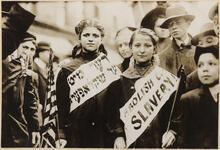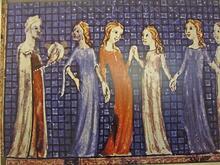Colonial Entrepreneurs: A Quartet of Jewish Women
Although Jewish women in the colonial period have often been overlooked, Esther Pinheiro, Esther Brown, Rachel Luis, and Simja De Torres all left written records documenting their activities. All four were widows, held property, and was at some point a merchant. Three of the four left wills, and three were literate. All had recorded connections to Jewish institutions or traditions, and many had connections to the Caribbean.
Wills and Religion
Esther Pinheiro, Esther Brown, Rachel Luis, and Simja De Torres were widows, each held property, and each was at one time or another a merchant. Although all lived in New York City for a time, none were born there. Pinheiro died on the Island of Nevis, the other three in New York. The four women had recorded connections to Jewish institutions or traditions; some of them supported synagogues, while others expressed a desire to be buried in the Jewish custom. All four have been overlooked by history. They have been included here because written records survive documenting their activities.
Brown left a will as well as a detailed inventory of her estate. De Torres and Luis left wills. De Torres seems to have been illiterate as far as English is concerned, leaving only her mark on her last testament. The others used their full signatures, though those of Luis and Brown are basically death scrawls done at the very last minute at their last breath. Thus, two or three seem educated, a rather high percentage for women of the colonial period. Of twenty-seven extant wills of Jewish men for the period, only six were unsigned.
There appears to be an identification with religion and religious institutions held in common by the group. De Torres left money to Congregation Shearith Israel and the synagogue in Kingston, Jamaica. Luis provided proceeds from the sale of household “furniture such as bed, bedding, chairs, table, and cubbard spoons” to be used to buy a “Shefer Tora” (Torah she-bi-khetav: Lit. "the written Torah." The Bible; the Pentateuch; Tanakh (the Pentateuch, Prophets and Hagiographia)Torah) for the New York congregation.
Brown was “Penitent and sorry from the bottom of my heart for my sins past” and awaited forgiveness from God and hope of the “glorious resurrection on the last day.” This curious Christian imagery was perhaps used by the clerk writing her will. De Torres and Luis both asked to be buried in the manner and ceremony of the “Jewish nation.” The four witnesses to the Brown will, Joseph Bueno, Abraham De Lucena, Nathan Simpson, and Mordecai Gomez, took their oaths on the Torah, and she was buried “Decently” in the Bet Haim (Shearith Israel Cemetery).
Esther Brown
Esther Brown (sometimes Hester) died on May 28, 1708, just after (or when) she signed her will. Her daughter Abigail was immediately made executrix. Widow Brown married Saul Pardo (Brown is the Anglicized version), the first known hazan in New York and a merchant, who died in 1703. The couple had six children, four of whom, Josiau, Abigail, Sarah, and Simja, were alive at Esther Brown’s death. They all died in Curaçao.
Brown continued her husband’s general merchandise business, not too unusual for colonial women. On March 22, 1708, she imported twenty-five gallons of rum from St. Thomas, aboard the sloop Flying Horse. She died two months later; it seems quite suddenly. The date of birth of one child is known: Josiau, in New York on September 22, 1694. Since she died some fourteen years later, she was then seemingly about thirty-five to forty years old at her death. Her inventory taken July 1, 1708, included furniture, one oval table, seven leather chairs, one “Ordinary Cubbard,” a “Japan dressing box,” and a large quantity of cloth, surely used in business, flannel, silk crape, damask, five pair of ordinary sheepskin gloves, four pair of coarse women’s stockings, and twenty gallons of fine aniseed water plus an additional fifteen gallons “made here.” The inventory was signed by Governor Edward Cornbury on July 14, 1708.
Simja De Torres
Simja De Torres, daughter of Moses de Silva, came to New York from Jamaica, though her place of birth is not known. Her year of birth is given as 1677. She was the wife of merchant Joseph De Torres, who died in 1724 in Jamaica. She too continued her husband’s business, being active in the slave trade. On July 19, 1742, she imported three slaves. Earlier, on March 19, 1728, she had bought four slaves abroad the ship Duke of Portland, one of whom was under four years old and “one for my person,” the latter thus being exempt from any import duty.
She wrote her will on February 16, 1744, and it was probated November 13, 1746, De Torres having died October 23, 1746. In her will, she devised to her “nease” Rebecca Da Silva “one Negrow Girle,” and to another “nease” Rachel Da Silva another “negro gireal.” Still another “negro gireal” was given to still another “nease,” Simja Da Silva. The remainder of her estate was given to her grandson, Moses Gomez. If Moses died before marriage or reaching age twenty-one, her estate went to her son-in-law, Daniel Gomez.
Esther Pinheiro
Esther Pinheiro, wife of Isaac Pinheiro (d. 1710), was married in Amsterdam in 1656. Her mother was Rachel Pinheiro, and the family was originally from Madrid. She received from her husband his Nevis plantations, “Negros,” the profits of his mill, and the rest of his estate not devised to his five children, two boys and three girls. Eighteen slaves were listed by name. Before she left for Nevis, Pinheiro went into business. In 1707, she purchased from Governor Edward Cornbury a slave, Bastiana. In 1716 through 1718, either she or her ships were in Boston and New York, where they traded salt, molasses for timber, fish, and European goods.
Rachel Luis
Rachel Luis surely died right after signing her will on April 8, 1737. Money from her estate was to be used to purchase a Torah for Congregation Shearith Israel, while her executor, David Machado, provided money for an “Escaba” or memorial prayer. She seemingly left neither children nor family. At least a good part of her estate was derived from trade.
The lives of these four relatively obscure women touched many. Certainly, they contributed to history.
Bloch, Julius M., Leo Hershkowitz, Kenneth Scott, and Constance Sherman, eds. An Account of Her Majesty’s Revenue in the Province of New York, 1701–1709 (1966).
Emmanuel, Isaac S. Precious Stories of the Jews of Curaçao, 1656–1957 (1975).
Hershkowitz, Leo. Wills of Early New York Jews, 1704–1799 (1967).
Marcus, Jacob R. The Colonial American Jew, 1492–1776 (1970).
Verdooner, Dave, and Harman Snel. Jewish Marriages in Amsterdam (1995).











